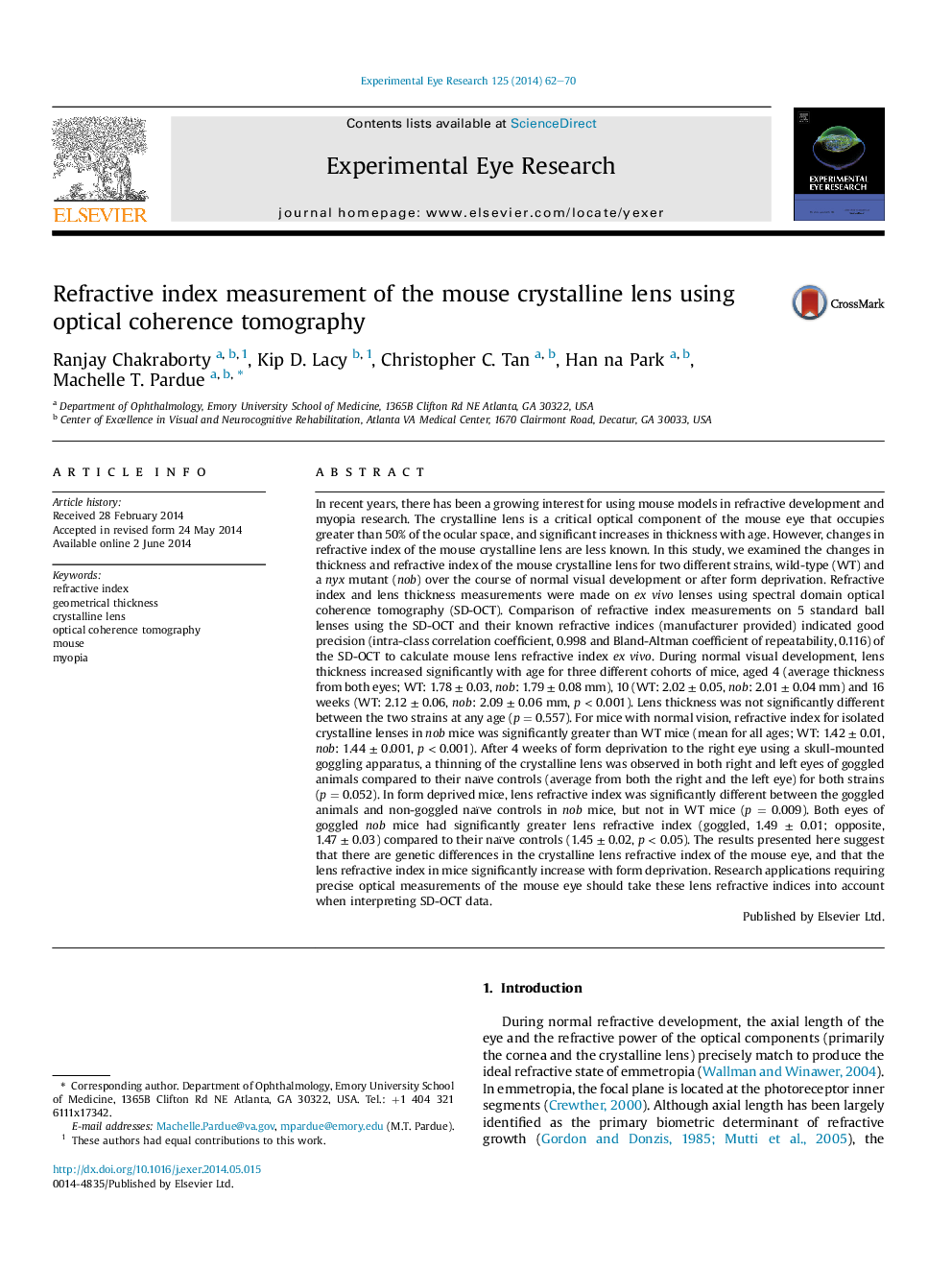| کد مقاله | کد نشریه | سال انتشار | مقاله انگلیسی | نسخه تمام متن |
|---|---|---|---|---|
| 6196945 | 1602597 | 2014 | 9 صفحه PDF | دانلود رایگان |
- Optical coherence tomography can be used to measure mouse lens refractive index.
- Mouse crystalline lens thickness increased with age.
- Mouse lens refractive index is altered by the retinal gene mutation Nyx in nob mice.
- Mouse lens refractive index increased with form deprivation myopia in nob mice.
In recent years, there has been a growing interest for using mouse models in refractive development and myopia research. The crystalline lens is a critical optical component of the mouse eye that occupies greater than 50% of the ocular space, and significant increases in thickness with age. However, changes in refractive index of the mouse crystalline lens are less known. In this study, we examined the changes in thickness and refractive index of the mouse crystalline lens for two different strains, wild-type (WT) and a nyx mutant (nob) over the course of normal visual development or after form deprivation. Refractive index and lens thickness measurements were made on ex vivo lenses using spectral domain optical coherence tomography (SD-OCT). Comparison of refractive index measurements on 5 standard ball lenses using the SD-OCT and their known refractive indices (manufacturer provided) indicated good precision (intra-class correlation coefficient, 0.998 and Bland-Altman coefficient of repeatability, 0.116) of the SD-OCT to calculate mouse lens refractive index ex vivo. During normal visual development, lens thickness increased significantly with age for three different cohorts of mice, aged 4 (average thickness from both eyes; WT: 1.78 ± 0.03, nob: 1.79 ± 0.08 mm), 10 (WT: 2.02 ± 0.05, nob: 2.01 ± 0.04 mm) and 16 weeks (WT: 2.12 ± 0.06, nob: 2.09 ± 0.06 mm, p < 0.001). Lens thickness was not significantly different between the two strains at any age (p = 0.557). For mice with normal vision, refractive index for isolated crystalline lenses in nob mice was significantly greater than WT mice (mean for all ages; WT: 1.42 ± 0.01, nob: 1.44 ± 0.001, p < 0.001). After 4 weeks of form deprivation to the right eye using a skull-mounted goggling apparatus, a thinning of the crystalline lens was observed in both right and left eyes of goggled animals compared to their naïve controls (average from both the right and the left eye) for both strains (p = 0.052). In form deprived mice, lens refractive index was significantly different between the goggled animals and non-goggled naïve controls in nob mice, but not in WT mice (p = 0.009). Both eyes of goggled nob mice had significantly greater lens refractive index (goggled, 1.49 ± 0.01; opposite, 1.47 ± 0.03) compared to their naïve controls (1.45 ± 0.02, p < 0.05). The results presented here suggest that there are genetic differences in the crystalline lens refractive index of the mouse eye, and that the lens refractive index in mice significantly increase with form deprivation. Research applications requiring precise optical measurements of the mouse eye should take these lens refractive indices into account when interpreting SD-OCT data.
Journal: Experimental Eye Research - Volume 125, August 2014, Pages 62-70
